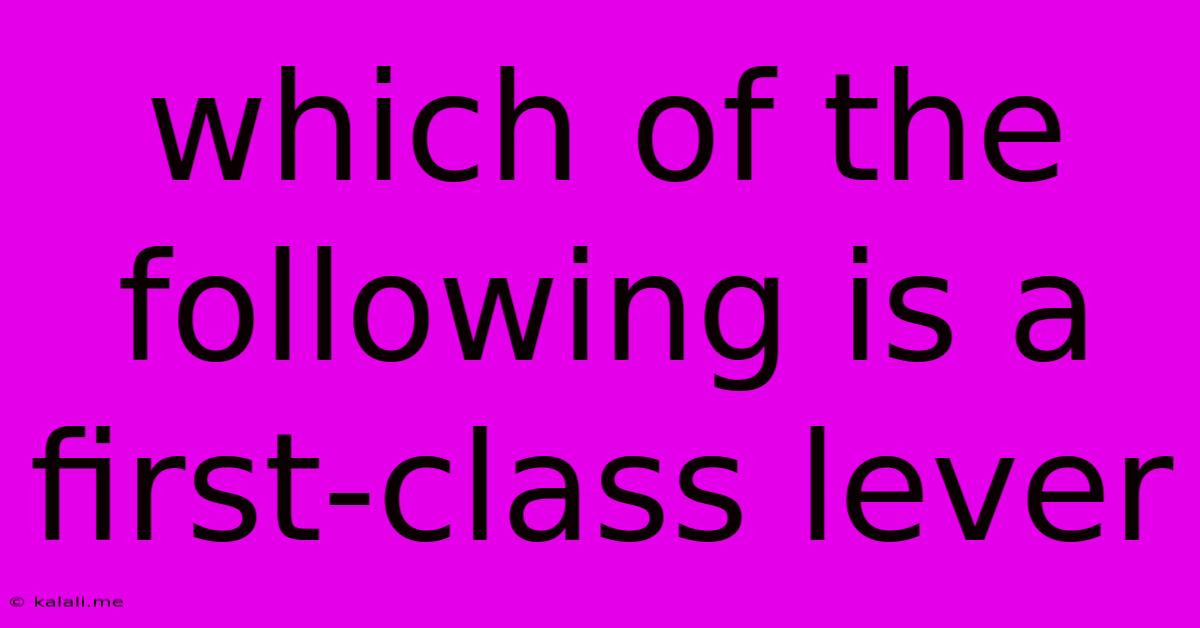Which Of The Following Is A First-class Lever
Kalali
Jun 15, 2025 · 3 min read

Table of Contents
Which of the Following is a First-Class Lever? Understanding Lever Classes and Their Applications
This article will explore the different classes of levers and definitively answer the question: which of the following is a first-class lever? We'll examine the characteristics of each lever class, providing clear examples to solidify your understanding. This knowledge is crucial for anyone studying mechanics, physics, or simply curious about the principles behind simple machines.
What is a Lever?
A lever is a simple machine consisting of a rigid bar that pivots around a fixed point called a fulcrum. Levers are used to amplify an input force to provide a greater output force, making work easier. They're incredibly common, appearing in everything from seesaws to crowbars.
The Three Classes of Levers:
Levers are categorized into three classes based on the relative positions of the fulcrum, effort (input force), and load (output force):
-
First-Class Lever: The fulcrum is located between the effort and the load. This arrangement allows for both mechanical advantage and speed advantage, depending on the placement of the fulcrum relative to the effort and load.
-
Second-Class Lever: The load is located between the fulcrum and the effort. This type of lever always provides a mechanical advantage, meaning a smaller effort force can move a larger load.
-
Third-Class Lever: The effort is located between the fulcrum and the load. This class prioritizes speed and range of motion over mechanical advantage. The effort required is always greater than the load.
Identifying a First-Class Lever:
To identify a first-class lever, remember the key characteristic: the fulcrum is in the middle. Here are some common examples:
-
See-saw: The fulcrum is the pivot point in the center, with the effort applied at one end and the load (the other person) at the other.
-
Crowbar: When used to pry something open, the fulcrum is the point where the crowbar rests against the object. The effort is applied at the handle, and the load is the object being pried.
-
Scissors: The fulcrum is the pivot point in the middle of the scissors, the effort is applied at the handles, and the load is the material being cut.
-
Pliers: Similar to scissors, the fulcrum is the rivet connecting the two handles, effort is the squeeze of the handles, and the load is the material being gripped or bent.
-
Balance scale: This classic measuring instrument utilizes a central fulcrum to compare weights.
Examples to Consider (Hypothetical):
Let's say you're given a multiple choice question:
Which of the following is a first-class lever?
a) A wheelbarrow b) A pair of tongs c) A seesaw d) A bottle opener
The correct answer is c) A seesaw. A wheelbarrow is a second-class lever, tongs are third-class levers, and bottle openers can be either, depending on design, but typically incorporate a combination of levers, not just a singular first-class lever.
Conclusion:
Understanding the different classes of levers is essential for appreciating the principles of simple machines. By remembering the placement of the fulcrum, effort, and load, you can easily identify a first-class lever and apply this knowledge to various real-world scenarios. The ability to analyze simple machines is a valuable skill in multiple fields, showcasing the importance of understanding basic physics and engineering principles.
Latest Posts
Latest Posts
-
How Many Square Meters In A Mile
Jun 16, 2025
-
Which Of The Following Represents An Alpha Particle
Jun 16, 2025
-
The Planet With The Lowest Average Density Is
Jun 16, 2025
-
Number Of Valence Electrons In Cl Ion Are
Jun 16, 2025
-
Differentiate Between Leading Strand And Lagging Strand
Jun 16, 2025
Related Post
Thank you for visiting our website which covers about Which Of The Following Is A First-class Lever . We hope the information provided has been useful to you. Feel free to contact us if you have any questions or need further assistance. See you next time and don't miss to bookmark.